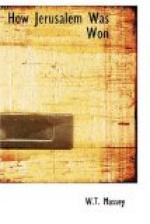The rabbit wire roads were a remarkable success. Motor wheels held firmly to the surface, and when the roads were in good condition cars could travel at high speed. Three or four widths of wire netting were laced together, laid on the sand and pegged down. After a time loose pockets of sand could not resist the weight of wheels and there became many holes beneath the wire, and the jolting was a sore trial alike to springs and to a passenger’s temper. But here again constant attention kept the roads in order, and if one could not describe travelling over them as easy and comfortable they were at least sure, and one could be certain of getting to a destination at an average speed of twelve miles an hour. In sand the Ford cars have performed wonderful feats, but remarkable as was the record of that cheap American car with us—it helped us very considerably to win the war—you could never tell within hours how long a journey would take off the wire roads. Once leave the netting and you might with good luck and a skilful driver get across the sand without much trouble, but it often meant much bottom-gear work and a hot engine, and not infrequently the digging out of wheels. The drivers used to try to keep to the tracks made by other cars. These were never straight, and the swing from side to side reminded you of your first ride on a camel’s back. The wire roads were a great help to us, and the officer who first thought out the idea received our daily blessings. I do not know who he was, but I was told the wire road scheme was the outcome of a device suggested by a medical officer at Romani in 1916, when infantry could not march much more than six miles a day through the sand. This officer made a sort of wire moccasin which he attached to the boot and doubled the marching powers of the soldier. A sample of those moccasins should find a place in our War Museum.
CHAPTER VI
Preparing for ‘zero day’
About the middle of August it was the intention that the attack on the Turks’ front line in Southern Palestine should be launched some time in September. General Allenby knew his force would not be then at full strength, but what was happening at other points in the Turkish theatres of operations might make it necessary to strike an early blow at Gaza to spoil enemy plans elsewhere. However, it was soon seen that a September advance was not absolutely necessary. General Allenby decided that instead of making an early attack it would be far more profitable to wait until his Army had been improved by a longer period of training, and until he had got his artillery, particularly some of his heavy batteries, into a high state of efficiency. He would risk having to take Jerusalem after bad weather had set in rather than be unable, owing to the condition of his troops, to exploit an initial success to the fullest extent. How wholly justified was this decision the subsequent fighting




